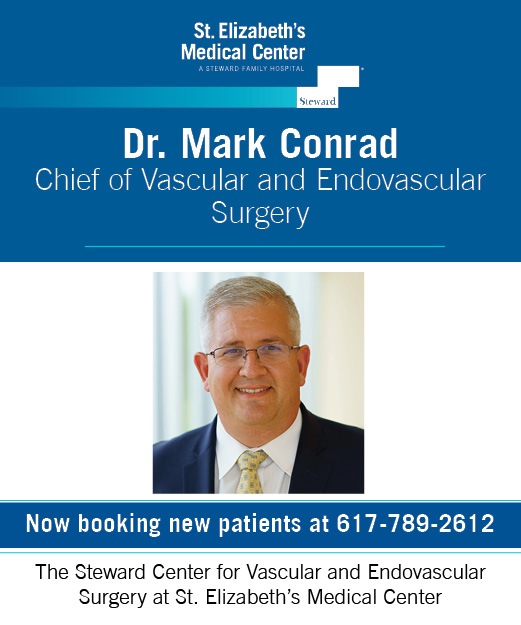Dealing with Spider or Varicose Veins? This Boston Vascular Surgeon Can Help

/ Getty Images
Our veins are like the gas lines in our cars, the pipes that bring water to our kitchens and bathrooms, the power lines and wires that deliver electricity to our homes. The common link? They are all essential. If there’s a malfunction, cars are damaged, sinks and showers run dry, and homes become cold and dark. Just the same, if there’s a problem with your veins, which carry blood to your heart, your health and overall quality of life is put at stake.
If you suspect you have spider or varicose veins, here to help is Dr. Mark Conrad, Vascular surgeon at St. Elizabeth’s Medical Center in Boston. Dr. Conrad has some expert insight that will help put an end to your discomfort.
How do you know if you have spider or varicose veins?
Since everyone’s veins look different regardless of any abnormalities, spider and varicose veins can be difficult to identify. Dr. Conrad says spider veins are smaller in size, and they stem from the capillaries, which are the smallest veins in the body. “They get their name from their appearance, which is similar to a spider web,” he says.
Varicose veins are raised, swollen blood vessels that are much larger than spider veins. “They are branches of the main veins that have grown in size due to a faulty valve or a weakness in the blood vessel wall,” says Dr. Conrad.
How do these conditions surface?
“Anybody can get spider or varicose veins at any stage in life,” says Dr. Conrad. “They typically appear as the body ages and valves weaken, and there a variety of factors that can contribute to their development.” He notes lifestyle, as in having a job where you exclusively sit or stand, genetics, since the conditions are often inherited, obesity, since more weight adds pressure on veins, and rapid changes in weight, such as during pregnancy.
“Women are more likely to get these veins due to fluctuations in hormones throughout their life, and they often appear during pregnancy or menopause,” he says.
What symptoms can you expect if you have spider or varicose veins?
Dr. Conrad first notes that many people never experience any symptoms of spider or varicose veins. “However,” he says, “varicose veins can become bothersome, and a person may feel cramping, aching or even throbbing in the legs after standing for longer periods of time.” He recommends elevating your legs or wearing compression stockings to ease the aching.
Sometimes, varicose veins can become more serious and lead to worse conditions. Dr. Conrad points to thrombosis, where a blood clot forms in the vein and leads to inflammation. “If a patient feels any discomfort or would simply like to discuss removing the veins for cosmetic reasons,” he says, “they can talk to their doctor about seeing a vascular surgeon to help treat their veins.”

What treatment options do you have?
Sclerotherapy
This is a procedure where the doctor injects a solution directly into the vein. “The solution irritates the vein and causes the walls to close off,” says Dr. Conrad. “It eventually turns into scar tissue and is reabsorbed into the body, effectively disappearing from sight.”
This highly effective method usually takes between six and eight weeks to work on spider veins, and three-to-four months to treat varicose veins. It takes several rounds of treatment but is very successful.
Foam Sclerotherapy
“Foam sclerotherapy is a relatively new method to treat larger veins that traditional sclerotherapy may not be able to address,” says Dr. Conrad. First, a sterile foam that resembles shaving cream is injected into the vein to displace the blood. Then, the sclerotherapy solution is injected into the vein. With the addition of blood displacement with the foam, the solution can have more direct contact with the vein walls.
Ablation
Vein ablation is used to close off the blood supply to varicose veins. It is typically used for larger or more complex cases of varicose veins. “The procedure involves your vascular surgeon using either heat or a chemical to injure the vein and cause it to close,” says Dr. Conrad. “The vein will scar, and your body will eventually absorb the scarred vein.”
Taking under an hour, this procedure is minimally invasive and usually begins to yield results within one week. In several weeks or months (depending on the prominence of the vein), they will fully disappear.
How do you know when to see a vascular surgeon?
“Varicose veins are often considered a cosmetic issue, but they can be a sign of more serious venous conditions,” says Dr. Conrad. “If you have concerns about the veins in your legs, you should have a vascular surgeon assess your legs and discuss treatment options with you.”
If you have spider veins and no symptoms, you will usually just get a physical examination and discuss treatment options with the doctor. “If you are having pain, swelling, bleeding or superficial clotting, you will be evaluated with an ultrasound as well,” Dr. Conrad says.
“Patients will see improvement with each treatment until the veins are eventually gone,” he says. “This should give them the confidence to show their legs again.”
For more vein wellness information and to schedule a visit at St. Elizabeth’s Medical Center today, visit semc.org/vein-center.
This is a paid partnership between St. Elizabeth's Medical Center and Boston Magazine


